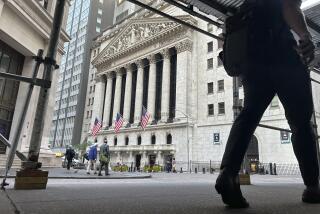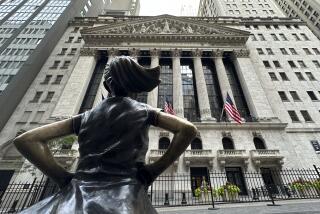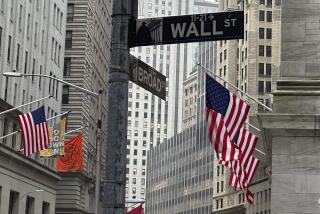Dow Up but Still Below 10,000
Wall Street emerged at least temporarily from its slump Tuesday as bargain hunting lifted stocks despite another set of lackluster earnings and a dip in consumer confidence.
Analysts cautioned against too much enthusiasm about the advance, however, noting that the market’s pattern has been to rally and then pull back when investors’ expectations fail to mesh with reality. Indeed, although stocks ended the day higher, the gains faded late in the session.
“You’re really just getting a snapback today,” said Duncan Richardson, chief equity investment officer at Eaton Vance. “The stocks that were down the most last week are up the most today. But I don’t think there’s been any broader change.”
The Dow Jones industrial average closed up 126.35 points, or 1.3%, at 9,946.22, after rising as much as 186 points earlier in the session.
It was the Dow’s first triple-digit gain in two weeks but failed to propel the average back above 10,000. This is the third-straight session the blue chips have spent below the psychologically important level.
Broader stock indicators also moved higher. The technology-focused Nasdaq composite index gained 31.30 points, or 1.9%, at 1,688.23, while the Standard & Poor’s 500 index climbed 11.47 points, or 1.1%, to 1,076.92, snapping a six-day losing streak.
The gain brought the S&P; 500’s loss for April to about 6%, the benchmark gauge’s worst monthly performance since September. The Dow fell 4.4% for the month, and Nasdaq sank 8.5%.
Although earnings Tuesday weren’t any more or less spectacular than others released previously, Wall Street was more willing to set aside some of its qualms--at least for the moment. Analysts said stock prices, which have fallen to 52-week lows and even new lows in some cases, were drawing investors to the market.
Cyclical, or economically sensitive stocks, helped buoy the Dow. International Paper rallied $2.28 to $41.43. United Technologies, whose products range from military aircraft to elevators, jumped $2.27 to $70.17. And Caterpillar, the world’s largest construction equipment maker, rose $1.73 to $54.62.
Still, Wall Street’s enthusiasm was selective. Eli Lilly tumbled $2.25 to $66.05 after the drug company backed its second-quarter forecast but lowered its outlook for 2002 and 2003.
Overall, winners led losers by 2 to 1 on the New York Stock Exchange and by 3 to 2 on Nasdaq. Trading was active.
The day’s economic news was unremarkable. The Conference Board said its consumer confidence index fell in April compared with March, but the drop was expected. The survey is closely watched because consumer spending accounts for two-thirds of the economy.
Another report showed manufacturing in the Chicago area grew in April for the third straight month.
In other trading, the dollar firmed against the euro and yen, although it still fell 3.2% against both currencies in April. Yields on Treasury securities dipped, oil fell and gold came off its recent two-year highs, falling $2.30 to $308.90 an ounce.
In other market news:
* Retail stocks lagged on the drop in consumer confidence and a report that retail sales fell last week. Wal-Mart lost 34 cents to $55.86, while Home Depot fell 59 cents to $46.37.
* Financial stocks surged, including Dow member J.P. Morgan, which rose 76 cents to $35.10. Bank of America gained $1.21 to $72.48 and FleetBoston added $1.05 to $35.30.
* Marquee technology names rose after days of declines. Cisco Systems rose 52 cents to $14.65 and Intel rose 57 cents to $28.61.
* Tyco International rose $1.45 to $18.45 and was the most active on the Big Board. The conglomerate said it doesn’t have liquidity problems because proceeds from its planned initial public stock offering of CIT Group will enable it to refinance $3.2 billion in debt.
Market Roundup, C8-9
More to Read
Inside the business of entertainment
The Wide Shot brings you news, analysis and insights on everything from streaming wars to production — and what it all means for the future.
You may occasionally receive promotional content from the Los Angeles Times.










